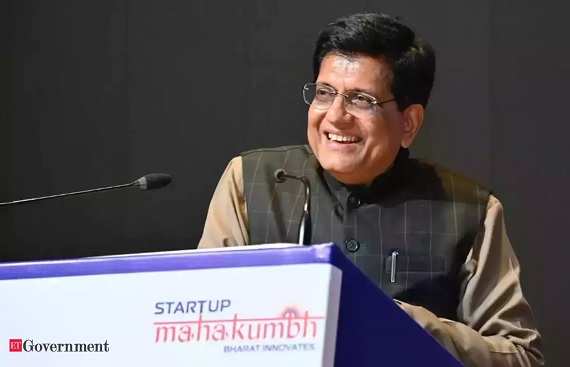India to Act as a Trusted Bridge of Global Connectivity Through IMEC: Piyush Goyal
By
siliconindia | Thursday, 17 April 2025, 04:40 Hrs

India is set to become a reliable bridge of global connectivity through the India-Middle East-Europe Economic Corridor (IMEC), Union Minister of Commerce and Industry Piyush Goyal stated while delivering the IMEC High-Level Roundtable on Connectivity and Economic Growth in New Delhi. The roundtable, organized by the Ministry of Commerce and Industry, brought together principal stakeholders from partner countries to discuss the transformative potential of IMEC as a contemporary connectivity initiative.
Goyal portrayed IMEC as an innovative and visionary idea that reflects the partnership and shared leadership of India, the Middle East, and Eastern Europe. He explained that the corridor has stirred the imagination of the international community by positioning itself as a Silk Route of today based on equality, mutual benefit, and shared prosperity. The IMEC, according to Goyal, is not merely a geographical trade corridor but a strategic partnership that will fuel economic integration, save costs, and facilitate easier flows of trade across continents. He noted that the effort promises to lower logistics costs by as much as 30 percent and transportation time by up to 40 percent, which will make cross-border trade more efficient and cost-effective.
Goyal said the project goes beyond the simple movement of goods. "We will not only be linking trade; we will be linking civilisations and cultures—from Southeast Asia to the Gulf, from the Middle East to Central Europe", he said. He also added that IMEC could potentially take its influence to Africa through the Middle East, thus providing another layer of strategic connectivity. The corridor is envisaged to include an vast array of infrastructure such as railways, road networks, energy pipelines, undersea telecommunication cables, and clean energy systems. The minister added that India is already in active talks with nations like Singapore on clean energy transmission and is in talks with regional powers like Saudi Arabia and the UAE on similar initiatives.
Emphasizing the fundamental tenets of the IMEC, Goyal averred that the program is based on sustainability, digital connectivity, and respect for each other's sovereignty and territorial integrity. He reaffirmed that the IMEC is not aimed at dominance and economic coercion but at establishing a partnership based on inclusiveness, trust, and sustainable development.
Five major recommendations were made by Goyal to ensure the effective fulfillment of the IMEC. First, he emphasized the importance of taking up a Public-Private Partnership (PPP) mode to build and run the corridor. He was of the opinion that the only government model would restrict innovation and financial viability as well. In contrast, he advocated for direct participation of the private sector whose operational acumen and innovative orientation can make planning more economical and implementation more agile. This collaborative process would enable policy systems to develop simultaneously with actual-world solutions offered by industry leaders.
Second, Goyal emphasized regulatory connectivity beyond the physical infrastructure. He urged harmonized trade policies, simplified customs clearance, and standardized documentation between the participating countries. Drawing upon India's regulatory cooperation with the UAE as a case in point, he insisted that such harmonizations would eliminate bottlenecks and facilitate easy movement of trade. Goyal also highlighted the potential of India's Unified Payments Interface (UPI) as a model for the establishment of a shared digital payments platform that could enable smooth and inexpensive cross-border payments. He indicated that this model, with regular settlements in internationally accepted reserve currencies, could minimize financial friction and be replicated across IMEC. This may be complemented with other prominent trade structures, including free trade agreements with GCC and EU countries, while furthering cooperation on green hydrogen, renewable energy, and supply chain resilience.
In his third proposition, Goyal stressed the importance of innovative funding instruments for financing the humongous size of IMEC. He promoted the engagement of multilateral financial institutions and mooted instruments such as green bonds and long-term "IMEC Bonds" to finance the infrastructure of the corridor in a sustainable manner. These financial instruments, he opined, would not only provide long-term sustainability but also align with international sustainability targets.
Goyal's fourth suggestion was close co-operation with industry associations and trade bodies. He believed that they are best suited to recognize challenges on the ground, disseminate best practices in operations, and suggest how trade friction could be removed. Their co-operation would make the corridor visionary as well as aligned with business realities on the ground.
Finally, Goyal suggested including academic institutions and think tanks as part of building the IMEC. He was firm in saying that these kinds of organizations can offer necessary research capacities, forward-thinking ideas, and long-term perspectives. These inputs would contribute to policy design, devise imaginative solutions, and assist in capacity development required for maintaining and enlarging the corridor.
Summing up his observations, Goyal reiterated India's unshakeable commitment to the IMEC and to being at the forefront of promoting global collaboration. He invoked the ancient Indian philosophy of Vasudhaiva Kutumbakam the world is one family emphasizing India's willingness to be a sure, trusted bridge connecting regions, economies, and peoples.
